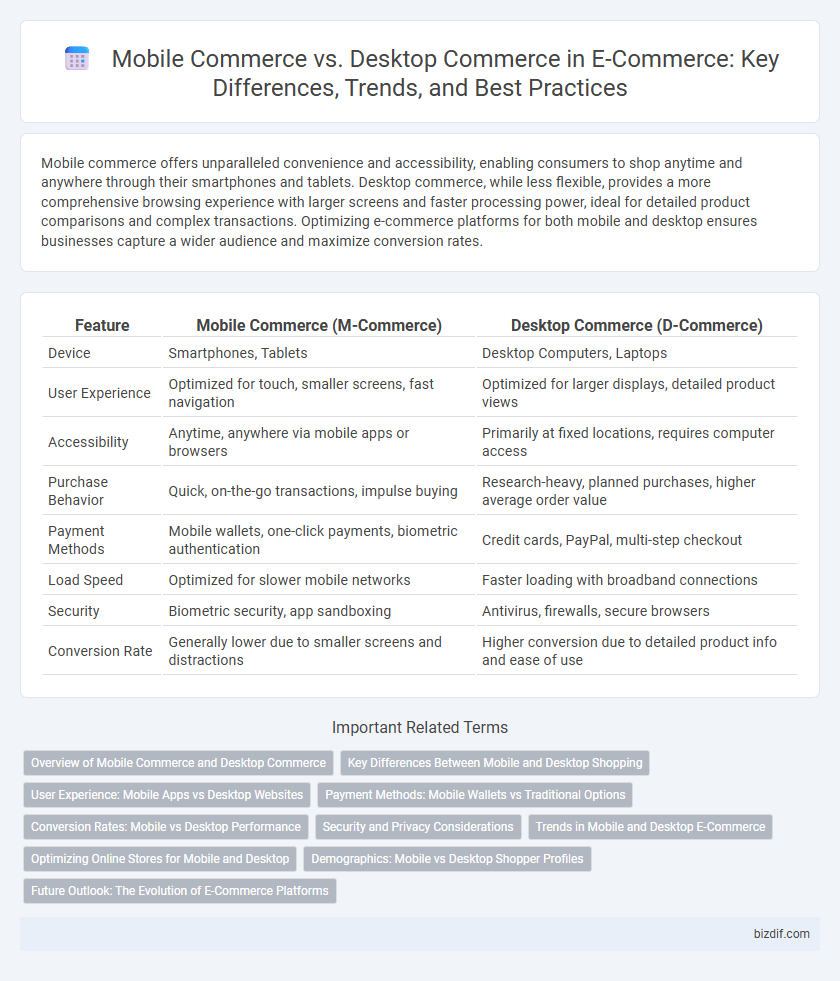Mobile commerce offers unparalleled convenience and accessibility, enabling consumers to shop anytime and anywhere through their smartphones and tablets. Desktop commerce, while less flexible, provides a more comprehensive browsing experience with larger screens and faster processing power, ideal for detailed product comparisons and complex transactions. Optimizing e-commerce platforms for both mobile and desktop ensures businesses capture a wider audience and maximize conversion rates.
Table of Comparison
| Feature | Mobile Commerce (M-Commerce) | Desktop Commerce (D-Commerce) |
|---|---|---|
| Device | Smartphones, Tablets | Desktop Computers, Laptops |
| User Experience | Optimized for touch, smaller screens, fast navigation | Optimized for larger displays, detailed product views |
| Accessibility | Anytime, anywhere via mobile apps or browsers | Primarily at fixed locations, requires computer access |
| Purchase Behavior | Quick, on-the-go transactions, impulse buying | Research-heavy, planned purchases, higher average order value |
| Payment Methods | Mobile wallets, one-click payments, biometric authentication | Credit cards, PayPal, multi-step checkout |
| Load Speed | Optimized for slower mobile networks | Faster loading with broadband connections |
| Security | Biometric security, app sandboxing | Antivirus, firewalls, secure browsers |
| Conversion Rate | Generally lower due to smaller screens and distractions | Higher conversion due to detailed product info and ease of use |
Overview of Mobile Commerce and Desktop Commerce
Mobile commerce (m-commerce) enables consumers to browse, purchase, and pay for products using smartphones and tablets, leveraging apps and responsive websites for seamless shopping experiences. Desktop commerce typically offers a more comprehensive interface with larger screen displays, facilitating detailed product comparisons and extended browsing sessions. Both channels contribute significantly to e-commerce revenue, with mobile commerce rapidly growing due to increased smartphone penetration and improved mobile payment solutions.
Key Differences Between Mobile and Desktop Shopping
Mobile commerce offers enhanced convenience with on-the-go access, optimized touch interfaces, and location-based services, while desktop commerce provides a more comprehensive browsing experience with larger screens and faster processing power. Mobile shopping emphasizes streamlined, app-based interactions and quick checkout processes, whereas desktop shopping supports detailed product comparisons and in-depth research. Conversion rates on desktops tend to be higher for complex purchases, but mobile commerce drives increased engagement and impulse buys due to its accessibility and personalized features.
User Experience: Mobile Apps vs Desktop Websites
Mobile commerce apps offer faster loading times, personalized interfaces, and seamless navigation tailored to touchscreens, enhancing user engagement and convenience. Desktop websites provide more extensive product details, larger visuals, and multitasking capabilities, supporting in-depth research and comparison shopping. Optimizing user experience for mobile apps requires prioritizing speed, simplicity, and intuitive design, while desktop platforms benefit from comprehensive content and easy access to multiple tabs or resources.
Payment Methods: Mobile Wallets vs Traditional Options
Mobile commerce payment methods prioritize convenience and speed, with mobile wallets like Apple Pay, Google Pay, and Samsung Pay enabling seamless, contactless transactions through smartphone apps and biometric authentication. Desktop commerce typically relies on traditional payment options such as credit/debit cards, PayPal, and bank transfers, which may require manual entry of payment data and longer checkout processes. The growing adoption of mobile wallets drives higher conversion rates and improved user experience on mobile platforms compared to desktop payment methods.
Conversion Rates: Mobile vs Desktop Performance
Mobile commerce conversion rates have steadily improved, currently averaging around 1.8%, while desktop commerce conversion rates remain higher, typically near 4.2%. Desktop users tend to exhibit stronger purchase intent due to easier navigation, faster load times, and more detailed product views. Optimizing mobile user experience with streamlined checkout processes and responsive design can significantly narrow the conversion gap between mobile and desktop platforms.
Security and Privacy Considerations
Mobile commerce demands heightened security measures due to increased vulnerability from public Wi-Fi and mobile app permissions, requiring robust encryption and two-factor authentication. Desktop commerce benefits from more sophisticated firewall and antivirus protections but faces risks from phishing and malware attacks targeting web browsers. Both platforms must prioritize data privacy compliance with regulations like GDPR and CCPA to protect consumer information during online transactions.
Trends in Mobile and Desktop E-Commerce
Mobile commerce continues to dominate e-commerce growth, with mobile devices accounting for over 70% of online retail traffic in 2024, driven by faster 5G networks and enhanced app experiences. Desktop commerce remains essential for higher-value purchases and detailed product research, contributing to approximately 30% of overall e-commerce revenue. Retailers optimize user interfaces for both platforms, leveraging responsive design and personalized marketing to cater to evolving customer preferences and increase conversion rates across mobile and desktop channels.
Optimizing Online Stores for Mobile and Desktop
Optimizing online stores for mobile and desktop requires adaptive design strategies that prioritize user experience and load speed across devices. Mobile commerce demands streamlined navigation, responsive layouts, and faster checkout processes to accommodate on-the-go shoppers, while desktop commerce benefits from detailed product displays and advanced filtering options. Implementing dynamic content delivery and device-specific performance enhancements boosts conversion rates and elevates overall customer satisfaction.
Demographics: Mobile vs Desktop Shopper Profiles
Mobile commerce shoppers predominantly consist of younger demographics aged 18-34 who favor convenience and on-the-go purchases, often using social media platforms for product discovery. Desktop commerce buyers are typically older, aged 35-54, valuing detailed product research and larger screens for comparison shopping. These distinct profiles influence marketing strategies, with mobile campaigns leveraging quick, visually engaging content and desktop efforts emphasizing comprehensive information and usability.
Future Outlook: The Evolution of E-Commerce Platforms
Mobile commerce continues to outpace desktop commerce with projections showing mobile sales accounting for over 70% of total e-commerce revenue by 2025. Advances in 5G technology, augmented reality shopping experiences, and AI-driven personalization are driving enhanced mobile user engagement and conversion rates. E-commerce platforms are evolving to offer seamless omnichannel integration, prioritizing mobile-first designs to capture the shifting consumer preference toward mobile devices.
Mobile Commerce vs Desktop Commerce Infographic

 bizdif.com
bizdif.com